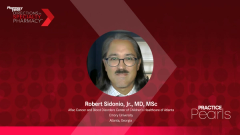
The Role of Prophylactic Therapy in Hemophilia A
Alexis Kuhn, PharmD, BCOP, explains the benefits, risks, and potential barriers associated with prophylactic therapy for patients with hemophilia A.
Episodes in this series

Jonathan Ogurchak, PharmD, CSP: Hello, and welcome to these Directions in Pharmacy® Practice Pearls: “Best Practices for Prophylactic Therapy in Hemophilia A.” I’m Jonathan Ogurchak, the CEO and cofounder of STACK, a pharmacy compliance-management software company. Joining me in this discussion are Anastasia Abramson, an advanced therapies pharmacist supervisor for AllianceRx Walgreens Prime in Pittsburgh, Pennsylvania; Alexis Kuhn, a pediatric hematology and oncology ambulatory care pharmacist at Mayo Clinic in Rochester, Minnesota; and Dr. Robert Sidonio Jr, the medical director of hemophilia for the Aflac Cancer and Blood Disorders Center of Children’s Healthcare of Atlanta and an associate professor of pediatrics at Emory University [School of Medicine]. Today we’re going to discuss several topics pertaining to best practices and the challenges faced in regard to prophylaxis in hemophilia A, including the role of prophylaxis, prophylactic therapy options, outpatient care factors, and economic considerations. Let’s dive in and get started.
First, I’d like to talk a little about the role of prophylaxis in hemophilia A. What’s the rationale for prophylactic therapy? What are some of those benefits and risks associated? Also, what are some of those barriers to its use? I’m not sure who wants to jump in and get started.
Alexis Kuhn, PharmD, BCOP: I can take the lead on this 1. When we think about the rationale for prophylactic therapy, the whole concept derived from the observation that in patients with less severe phenotypes, either moderate or mild hemophilia A, those patients are less likely to experience spontaneous bleeds, and thus they have lower lifetime burden of those joint arthropathy that can really limit the quality of life in individuals with hemophilia. The concept of prophylaxis is to administer hemostatic agents to hopefully transition a patient from what would be a severe bleeding phenotype into what would be a less severe phenotype. Of course, we know we can’t genetically change somebody from a severe to a moderate to a mild. However, by administering these hemostatic agents, we can hopefully modify their bleeding pattern.
As far as benefits of administering routine prophylaxis, the biggest thing is going to be limiting those bleeds. We know that in individuals who receive prophylaxis, we can significantly reduce the amount of bleeds that they have and associated long-term arthropathies as a result of those bleeds. In doing so, it’s like playing the long game. With fewer bleeds, you get less chronic damage and, hopefully, less chronic pain and disabilities later in life. With all those benefits, there are some risks pertaining to the agents themselves. When we think classically, our prophylaxis has been with clotting factor concentrates— we’ll talk about this later. Obviously, the big adverse effects or consequences with our clotting factor concentrates is the development of inhibitors, which is a serious consequence in our patients with hemophilia, so that really complicates management moving forward. That would be 1 big drawback or risk associated with prophylaxis with the clotting factor concentrates.
As far as barriers to use, imagine those clotting factor concentrates as we’re using the intravenous route of administration. Subsequently, in individuals with a lifetime disease, the burden that’s associated with administering some of these agents intravenously [IV] can be substantial. If you’re talking about a parent trying to wrangle a 2-year-old or 3-year-old and trying to administer this prophylactic IV therapy multiple times a week, that can be burdensome as well. The cost of therapy is substantial, and we’re really playing the long game. You may not necessarily appreciate the benefits in the short term, but sometimes those burdens of time and inconvenience associated with administering the therapies—coupled with the financial burden and potentially inaccessibility to these agents—can really dissuade someone against pursuing it regularly. Of course, the World Federation of Hemophilia, and the National Hemophilia Foundation’s Medical and Scientific Advisory Council make strong recommendations to administer prophylaxis to those patients with severe phenotype, so we know it’s beneficial. We want to do it, but there are some barriers to overcome.
Jonathan Ogurchak, PharmD, CSP: That’s great. Thank you so much. When it comes to prophylaxis, when exactly would prophylaxis be considered? I know that there are different modes and modalities to approach that. Dr. Sidonia?
Robert Sidonio Jr., MD, MSc: Just to build on what Alexis said, the idea of prophylaxis is really to mitigate the bleeding and to delay some of the long-term effects with hemarthrosis or joint bleeds. We know that prophylaxis will not eradicate that risk. You have to make somebody essentially normal. We don’t have that capability yet, but maybe in the future with gene therapy. Certainly, there are ways we manage this, and it wasn’t until the early 2000s, in the United States, following publication of the Joint Outcome Study that Dr [Marilyn] Manco-Johnson led, that we had a definitive strategy showing prophylaxis vs aggressive post-treatment was ideal.
One of those barriers and issues that came up is that the cost is significantly higher. There’s an extreme administrative burden, and we’ll talk about some alternative strategies here. But the general strategies that we’re trying to shift toward are primary prophylaxis, and that’s generally done prior to the age of 3, or after the first joint bleed. You could consider it before the first joint bleed, and typically that happens in the first 3 or 4 years of life. We’re really pushing patients and considering the long game, as Alexis said, of preventing bleeds. They may not see the benefit. They see only the amount of emotional trauma that it requires to administrate this.
Secondary prophylaxis is when you administer a prophylactic regimen, meaning factor doses; we’re talking about Factor VIII, Factor IX. When you institute this once or twice a week, or more often depending on the situation after at least 2 joint bleeds, you’ve waited until they’ve expressed a significant bleeding phenotype. Most of us have shifted away from that and typically are using primary prophylaxis. When you look at children, at least 80% to 90% of those with severe disease have started primary and less so secondary prophylaxis.
Certainly, we don’t want to forget about our adult patients. We have patients who have established joint disease. Maybe they were older when primary prophylaxis was the primary strategy and the optimal strategy. However, there still is some benefit, and that’s been shown in a number of studies. The SPINART study, for example, definitely shows a decreased number of bleeding events. You certainly can break the cycle of target joints in which you have multiple joint bleeds, in the same joint over a 6-month period. So, there’s still some benefit for the far older patients, those in their 40s or 50s, who may have established joint disease.
Transcript edited for clarity.
Newsletter
Stay informed on drug updates, treatment guidelines, and pharmacy practice trends—subscribe to Pharmacy Times for weekly clinical insights.









































































































































































































